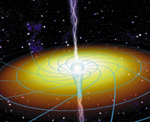RXTE Discoveries
RXTE Observes Space-Time Distortion - November 6, 1997
|
Astronomers Dr. Wei Cui of MIT, Dr. Wan Chen of NASA's Goddard Spaceflight Center and Dr. Shuang N. Zhang of NASA's Marshall Space Flight Center used RXTE to observe a black hole that appears to be dragging space and time around itself as it rotates! This effect is called "frame dragging" and it is something that Einstein's Theory of Relativity predicts. This is the first time that physical evidence to support this aspect of Einstein's 1918 theory has been available.
|  |
A black hole is a very massive compact object with a gravitational field so strong that not even light can escape its grasp. Because of this, black holes are most easily detected by observing their effects on other bodies of matter, for example, a companion star. A companion to a black hole will have matter pulled off it and into orbit around the black hole. As the matter spirals towards the black hole, it heats up and radiates x-rays.
What Dr. Cui and his collaborators have discovered is that the orbit of the hot, x-ray emitting gas around their black hole is being distorted, causing the x-rays to peak at periods that match the frame dragging predictions of general relativity. The x-ray emission repetitively varied in intensity, a phenomenon best explained by a perturbation, or precession in the matter's orbit around the black hole. In other words, the matter's orbit gets shifted every time it revolves around the black hole as the space-time that is being dragged around the black hole pulls the matter along with it.
A good analogy is a bowling ball immersed in molasses. When the bowling ball rotates, it drags the molasses with it, just like a black hole drags space-time.
The frame dragging effect was first predicted using general relativity by Joseph Lense and Hans Thirring in 1918. Appropriately named the Lense-Thirring effect, after the two Austrian physicists, this effect has never before been observed.
Dr. Cui says, "If our interpretation is correct, it could demonstrate the presence of frame dragging near spinning black holes. This observation is unique because Einstein's theory has never been tested in this way before."
Also using RXTE, an Italian team of astrophysicists may have detected this frame dragging around a neutron star. Both groups presented their results at the High Energy Astrophysics Division (HEAD) meeting in Colorado on November 6, 1997. Dr. Alan Bunner, the Director of the Structure and Evolution of the Universe (SEU) Program at NASA, commented, "This is exciting work that needs further confirmation, as for any seemingly major advance in science."


